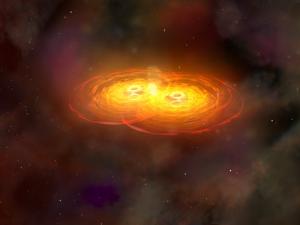Post
Black Hole Thermodynamics
9 September 2013
 NASA/CXC/A. Hobart
NASA/CXC/A. HobartIn the 1800s scientists studying things like heat and the behavior of low density gases developed a theory known as thermodynamics. As the name suggests, this theory describes the dynamic behavior of heat (or more generally energy). The core of thermodynamics is embodied by its four basic laws.
The zeroth law states that if object A is in thermodynamic equilibrium with object B (meaning no net energy flows between them), and object C is in thermodynamic equilibrium with B, then A and C are in thermodynamic equilibrium with each other. Since objects in thermodynamic equilibrium have the same temperature, another way to state this law is that if A has the same temperature as B, and C has the same temperature as B, then A and C have the same temperature. When you put it that way it seems quite obvious, which is why it isn’t known as the first law. The other laws were developed first, and as they were refined it became clear the zeroth law should be included as a physical property, not just an assumption.
The first law states that energy is conserved. Since heat is a form of energy, this means an object that is heating up must be getting energy from somewhere. Likewise, if an object is cooling down, the energy it loses must be gained by something else. Conservation of energy was known before thermodynamics, but this law recognized heat as a form of energy.
The second law is perhaps the most misunderstood law of thermodynamics. In its simplest form it can be summarized as “heat flows from hot objects to cold objects”. But the law is more useful when it is expressed in terms of entropy. In this way it is stated as “the entropy of a system can never decrease.” Many people interpret entropy as the level of disorder in a system, or the unusable part of a system. That would mean things must always become less useful over time, which is why evolution skeptics often claim it violates the second law of thermodynamics.
But entropy is really about the level of information you need to describe a system. An ordered system (say, marbles evenly spaced in a grid) is easy to describe because the objects have simple relations to each other. On the other hand, a disordered system (marbles randomly scattered) take more information to describe, because there isn’t a simple pattern to them. So when the second law says that entropy can never decrease, it is say that the physical information of a system cannot decrease. In other words, information cannot be destroyed.
The third law basically states that at absolute zero an object is at its minimum possible entropy (often taken as zero). One consequence of this law is that you cannot cool an object to absolute zero.
In an earlier post I wrote about how classical black holes have “no hair,” meaning that they are simply described by their mass, charge and rotation. Because of this, you could toss an object (with a great deal of entropy) into a black hole, and the entropy would simply go away. In other words, the entropy of the system would get smaller, which would violate the second law of thermodynamics. Another way of looking at it would be that the classical black hole has a temperature of absolute zero. This means you could take some hot mass and collapse it into a black hole, which would essentially be cooling an object to absolute zero, in violation of the third law of thermodynamics.
Of course, this ignores the effects of quantum mechanics. When we take quantum mechanics into account, black holes can emit light and other particles through a process known as Hawking radiation. Since a “quantum” black hole emits heat and light, it therefore has a temperature. This means black holes are subject to the laws of thermodynamics.
Integrating general relativity, quantum mechanics and thermodynamics into a comprehensive description of black holes is quite complicated, but the basic properties can be expressed as a fairly simple set of rules known as black hole thermodynamics. Essentially these are the laws of thermodynamics re-expressed in terms of properties of black holes.
The zeroth law states that a simple, non-rotating black hole has uniform gravity at its event horizon. This is kind of like saying that such a black hole is at thermal equlibrium.
The first law relates the mass, rotation and charge of a black hole to its entropy. The entropy of a black hole is then related to the surface area of its event horizon.
The second law again states that the entropy of a black hole system cannot decrease. One consequence of this is that when two black holes merge, the surface area of the merged event horizon must be greater than the surface areas of the original black holes.
The third law states that “extreme” black holes (those with a maximum possible rotation or charge) would have minimum entropy. This means that it would never be possible to form an extreme black hole. For example, it would never be possible to spin a black hole so fast that it would break apart.
The advantage of black hole thermodynamics is that provides a way to get a handle on the complex interactions black holes can have. Thermodynamic black holes have not just mass, charge and rotation, but also temperature and entropy. The rules first devised to describe the heating and cooling of simple gases also seems to apply to black holes.
But there are things we still don’t understand about black hole thermodynamics. I’ll talk about those next time.